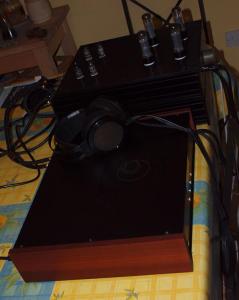-
Posts
5,414 -
Joined
-
Last visited
-
Days Won
32
Content Type
Profiles
Forums
Events
Everything posted by Craig Sawyers
-
Result! Happened twice to me, once with a pen and once with an HP calculator. Bought replacements - at which point the original escaped from the bowels of the cabin. I'm sure there are black holes whose purpose is to screw with your mind. It is where all my odd socks and allen keys go.
-
I haven't read any Lovecraft for a very long time. That is my wake up call to read or re-read a few of his very disturbing books.
-
Yes - A bit like Hichhiker's Guide "Every time I press one of these black controls, labelled in black on a black background, a little black light lights up black to let me know I've done it. " The only relief is the glow of the tubes and the awesome lignum vitae knob
-
Just for the record, there were three mods to the power supply and amp: (1) The power supply mod developed by Kevin and Inu to make it stable (2) Adding precautionary 750 ohm resistors in series with the gates of all K216's (3) Adding 5pF 1kV caps (I used ceramic, Inu used mica) across the 100k feedback resistors. That was also an Inu mod. (1) and (3) are essential IMHO. (2) is discretionary - these resistors were not present in the original from examination of the photos. It has already been said - this sucker runs real hot. Once it has been on for a few hours the heatsinks, front panel and top plate are toasty.
-
-
Omygod. I'm speechless and breathless - I've really heard nothing to compare with this. I could witter on about speed and clarity, and the tendency to listen to things far too loud because there is zero listening fatigue. Looks guys - I have a BH, and bloody good it is too. But KG's recreation of the T2 is simply in another league. OK - the right channel has noticeably hiss, but that is because I need to frig with the battery voltage a bit on that channel. What I need to do is stop listening for long enough to pull the lid off again. Mind you - it served up a bit of a fright. I'd had the thing on/off/on/off etc as I was messing around trying various cures for the 650kHz problem with no mishaps. Put all the covers on, heaters came up, but when the HT came on the fuse blew. WTF??? Tore covers back off to find the gremlin. There wasn't one - the 2AT fuse I had in the IEC was clearly not man for the inrush job (6.3A in there now) - but it waited until I'd put the gadzillions of screws in before it gave up the ghost.
-
At the moment a used Edicron quad that I had lying around that still measures pretty good. I've a good set of original Mullards that will probably end up in there, or I might get another set of Winged C (I've a set of those in the BH, and they sound very good indeed) and keep the Mullards for Sunday Best. I've got a set of Pearl tube coolers too - evening out variation in the envelope temperature and reducing it double tube life - something that was researched by Mullard etc back in the 50's. 6DJ8's are Mullard's pilfered from a wrecked Tektronix scope that measure right on the button.
-
WHOOOO! Squared! Second channel now operating. Adjusting those pots is pretty trivial having worked out what they actually do - and having halfway decent silicon in there. I'm going to award myself a run, some lunch, and then put the front panel on and have a listen
-
WHOOOOOO! First channel operating!!! RV1 and RV2 do exactly what the simulation and spreadsheet says, as is my suggested way of adjustment. Outputs sitting at -4.5V and batteries at 743V. I can probably get the output offset lower than that, but I'll now concentrate on the other channel for a while.
-
Way to go! That is another corner turned
-
Wierd factoid - I've missed every episode of this. But the general opinion (including critical acclaim in the UK) is so high that I have just got to get a set of DVD's of this and catch up.
-
I've done both. Both are active - all the battery does is apply a 740V DC level shift; from an ac point of view the battery is short circuited via C3.
-
Ah - that is interesting, Inu. I've added 750 ohms to mine as a precaution; we were clearly thinking along the same lines. Incidentally, I put a spreadsheet of battery voltage against RV1 and RV2 position from a spice simulation here http://www.tech-enterprise.com/tekstuff/Batteryvoltage.xlsx
-
"Snow" and "Mojave" are not words I would associate in the same sentence. Very wierd.
-
Equipped with my shiney new Spice models, I've had another go at the battery, this time with the bottom current source around Q30 modelled too. I've been investigating what RV1 and RV2 do in preparation for turning the thing back on in the coming days. RV1 does nothing much over quite a lot of its range. The model I have of the 2SK246 seems to have an Idss of 10mA, so turning RV1 *anticlockwise* initially has the battery completely off and at maximum voltage (790V or so) for the first 6.5k of its travel. The battery voltage then falls at 34V per turn of the pot. In the model, 740V is reached at 6.9k. This would appear to be the "coarse" control. RV2 is essentially linear at 3.7V per turn (ie around ten times more sensitive than RV1), and would appear to be the "fine" control. It operates over a total range of 90V. Clockwise reduces the voltage. So the strategy seems to be to set RV1 and RV2 to mid travel. Adjust RV1 to get withing striking distance of 740V (+/- 25V or so) and then fine trim with RV2. At least that is what the modelling says. I'll try it out in the coming days and report back.
-
Oh boy. I know precisely how you feel, and how difficult it is to break into a modern car. Worst for me was around ten years ago, in January, in a very remote car park. I'd been out for a trail run, and got back drenched with sweat, opened car and tossed keys on seat. Closed car door to go round and get dry kit out of the boot (trunk) and the central locking randomly fired, locking my keys in and leaving me getting progressively frozen standing outside. I'll not bore you with the tale of woe that ensued.
-
I've really been pasting this list thick and fast recently. But for anyone interested, here are a couple of spice models. The first is for the 2SA1413, which is a different package for the 2SA1486, and is a Sanyo model. The second is for the 2SC3675, generated by a downloaded SPICE parameter calculation spreadsheet downloaded from excel , with input data measured by me. That is essentially a dc model only, with no description of electrode capacitances, and nothing to do with inverse active mode. .MODEL 2SA1413 PNP (IS=153.22E-15 + BF=73.199 + VAF=104.34 + IKF=1.3862 + ISE=153.22E-15 + NE=1.3075 + BR=.357 + VAR=100 + IKR=3.7415 + ISC=63.966E-12 + NC=1.7723 + NK=.92315 + RB=.73481 + CJE=1.3316E-9 + VJE=.77186 + MJE=.38206 + CJC=140.65E-12 + VJC=1.1825 + MJC=.54838 + TF=5.0775E-9 + XTF=2.5439 + VTF=16.727 + ITF=193.71 + TR=30.928E-9 + NR=1 + NF=1 + TRC1=0 + TRB1=0 + XTB=1.5) .model 2SC3675 NPN (VAF=6000 IS=1.00290528476071E-14 +NF=.934004260398326 BF=150 NE=1.11055219144042 +ISE=9.61916074296322E-15 IKF=.1 +TF=2.6525846254073E-08 )
-
I don't know what others are seeing when they mention double posts. I'm only seeing one of each message (using IE8 ).
-
Latest hold up - LED's. D6,7,10,11 popped when I was in the crap C3675 phase. Replaced them with stock 5mm red LED's. But before switching on I thought I'd check the voltage. Ones specified by KG measure 1.8V at 0.5mA - which then gives the (calculated) currents on the schematic exactly. The ones I replaced them with measure 1.6V at 0.5mA. Does not seems much, but it shifts the operating point of the EL34's by 20%. So I am procuring more LED's, which puts a few days delay into the turn on. Ought to have bought a shed load more in the first place, since they are cheap. This sucker is going to be 100% according to design before it sees volts again.
-
3am, too much alcoholic anaesthetic. G'night and Happy New Year!
-
Um - pardon? I don't see double posts - you didn't do a New Year's Eve sampling while you sorted out the liquor cabinet
-
That is a real bummer to see 2010 out. Sorry to hear; I must admit that on the rare occasion that I've done something similar I always leave an apologetic note at least, and/or my phone number. But here in the UK, 20% of drivers have no insurance - yes, around 10 million drivers (plus) have no insurance. So there is little self-interest in such scumbags owning up. Hugely illegal of course. Police now have number plate recognition cameras in an attempt to root this out.
-
Right - several hours of T2 rebuild with measured semiconductors, and the beast is ready to roll again. However, I am now going to drink beer and cook. And we're out tomorrow visiting friends. So it will be Sunday when I do final checks, plug in the mains and hopefully not do this to myself.
-
I forgot to say - not connecting the amp ground to chassis safety ground (either hard grounding as Spritzer does, or ground lifting via a resistor as I prefer) is seriously bad in an electrostatic amp that can kill. Always connect the chassis to the green/yellow safety incoming mains in some way that cannot possibly come adrift; star washers to bare metal are manditory, as is removing paint or anodising where the chassis component bolt together to ensure the chassis is bonded to safety ground. Most commercial chassis (including all the Hammond ones I've used) omit this point entirely and just anodise or powder coat each plate so they are nicely insulated from one another, leaving it up to the user to take necessary measures to prevent death.
-
The problem is that Mosfet self oscillation is bewlideringly prone to both precise layout almost at the millimeter level, exactly where the bypassing is in relation to the transistor, and the gm of the transistors. There is a rather wide tolerance in gm, so perhaps an unlucky batch with high gm might be a trigger. There is an excellent Renesas apps note (simply called "Power Mos Fet Application Note" - 57 pages) which covers more Mosfet death mechanisms than I ever knew existed, parasitic self oscillation being only one. Maybe there could be some interaction with the input tubes which might explain the noisyness with some tubes that both you and Inu have mentioned. I don't have any stock of beads, so I'll go with the resistor and keep the value the same as for the J79.




